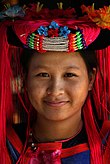
Back Lisu xalqı Azerbaijani ལི་སུའུ་མི། Tibetan Lisu Catalan Lĭk-sé̤ṳk-cŭk CDO Lisu Danish Lisu German Lisuoj Esperanto Lisu Spanish Lisu etnia Basque Lisut Finnish
ꓡꓲ‐ꓢꓴ လီဆူ 傈僳 | |
|---|---|
    | |
| Total population | |
| 1,400,000 (est.) | |
| Regions with significant populations | |
| 700,000[1] | |
| 600,000 | |
| 55,000 | |
| 5,000 | |
| Languages | |
| Lisu, Lipo, Laemae, Naw; Southwestern Mandarin (Chinese), Burmese, Thai | |
| Religion | |
| Christianity, Animism, and Buddhism | |
| Related ethnic groups | |
| |
| Lisu people | |||||||
|---|---|---|---|---|---|---|---|
| Chinese name | |||||||
| Chinese | 傈僳族 | ||||||
| |||||||
| Burmese name | |||||||
| Burmese | လီဆူလူမျိုး | ||||||
| Thai name | |||||||
| Thai | ลีสู่ | ||||||
The Lisu people (Lisu: ꓡꓲ‐ꓢꓴ ꓫꓵꓽ; Burmese: လီဆူလူမျိုး, [lìsʰù]; Chinese: 傈僳族; pinyin: Lìsùzú; Thai: ลีสู่) are a Tibeto-Burman ethnic group who inhabit mountainous regions of Myanmar (Burma), southwest China, Thailand, and the Indian state of Arunachal Pradesh.
About 730,000 Lisu live in Lijiang, Baoshan, Nujiang, Dêqên and Dehong prefectures in Yunnan Province and Sichuan Province, China. The Lisu form one of the 56 ethnic groups officially recognized by China. In Myanmar, the Lisu are recognized as one of 135 ethnic groups and an estimated population of 600,000. Lisu live in the north of the country; Kachin State (Putao, Myitkyina, Danai, Waingmaw, Bhamo), Shan State (Momeik, Namhsan, Lashio, Hopang, and Kokang) and southern Shan State (Namsang, Loilem, Mongton), and Sagaing Division (Katha and Khamti), Mandalay Division (Mogok and Pyin Oo Lwin). Approximately 55,000 live in Thailand, where they are one of the six main hill tribes. They mainly inhabit remote mountainous areas.[3]
The Lisu tribe consists of more than 58 different clans. Each family clan has its own name or surname. The biggest family clans well known among the tribe clans are Laemae pha, Bya pha, Thorne pha, Ngwa Pha (Ngwazah), Naw pha, Seu pha, Khaw pha. Most of the family names came from their own work as hunters in the primitive time. However, later, they adopted many Chinese family names. Their culture has traits shared with the Yi people or Nuosu (Lolo) culture.
- ^ "Ethnies chinoises". Chine-informations.com. Retrieved 17 August 2018.
- ^ Rahul Karmakar, https://www.hindustantimes.com/india-news/miss-arunachal-2017-pageant-to-have-quotas-for-tribes-with-china-roots/story-bd9IwH4iybVspzWJuuQviI.html
- ^ Ernst, Gabriel (21 October 2019). "'We try to not be Thai': the everyday resistance of ethnic minorities". New Mandala. Retrieved 20 April 2020.